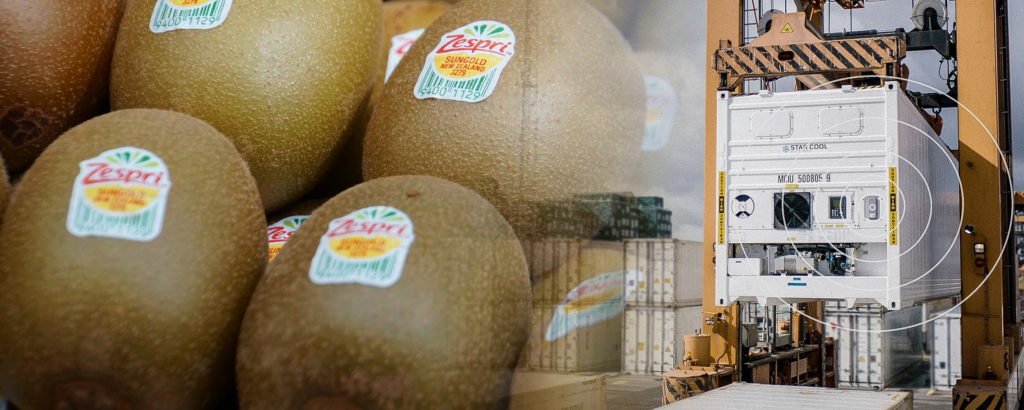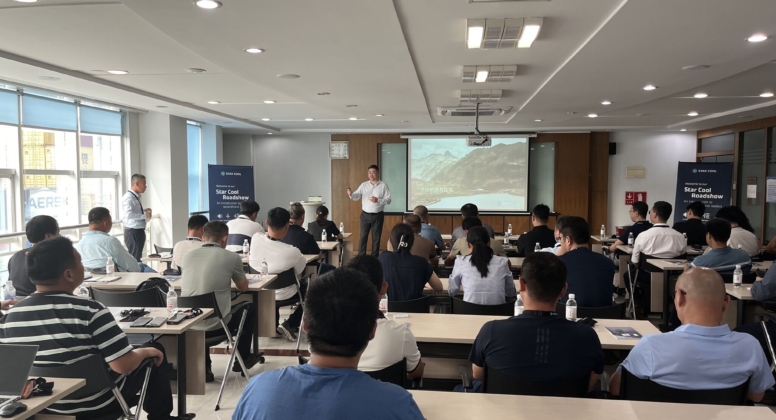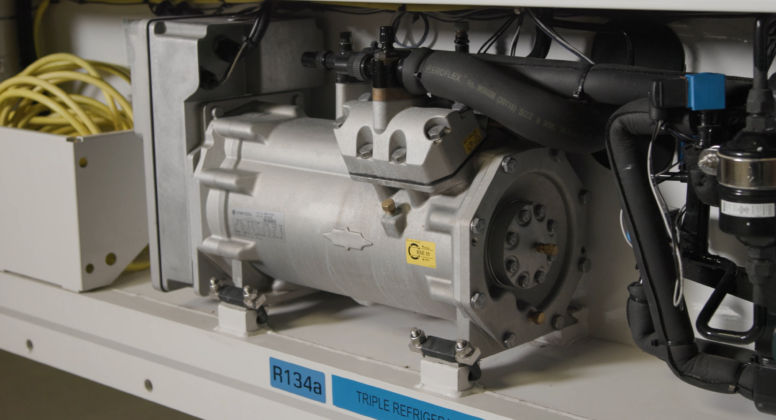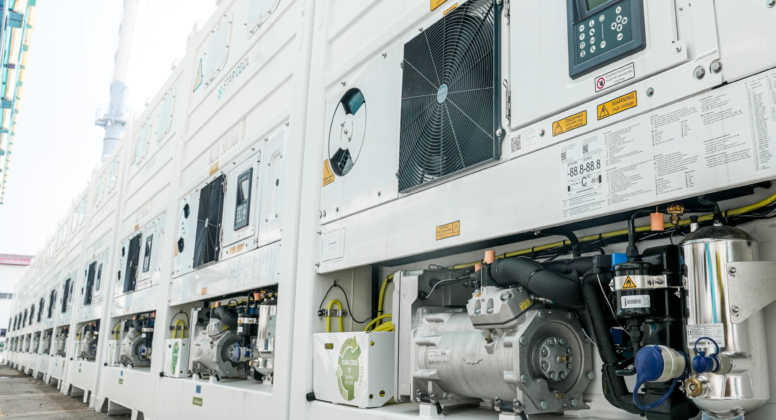Acting on reducing our CO2 footprint – Zespri International

Specialist in reefer shipping, supply chain and sustainability
Following our Q2 2022 article on this subject, we caught up with Rachel Depree, Executive Officer for Sustainability at Zespri International Ltd, New Zealand to learn about the ‘Kiwi’ approach to sustainability.
Q: New Zealand kiwifruit is renowned in the whole world for its quality and taste. When and how did the commercial journey of selling kiwifruit overseas start?
Our story originates from the challenges faced by the New Zealand kiwifruit industry in the 1980s.
Rapid expansion of the industry and large crop volumes saw supply exceed demand, which in combination with unfavourable foreign exchange and interest rates, resulted in the price of kiwifruit dipping to an all-time low. New Zealand kiwifruit growers decided they could do better together and so Zespri was formed in 1997 to manage kiwifruit innovation and the marketing of our growers’ fruit to the world. Zespri remains fully owned by growers.
Today, our growers produce more than 5.7 billion healthy kiwifruit a year. As the world’s leading kiwifruit brand, our purpose is to help people, communities, and the environment around the world thrive through the goodness of kiwifruit. And our mission is to create sustainable long-term value for kiwifruit growers, by offering consumers the world’s leading portfolio of branded kiwifruit 12 months of the year.

We do this by supplying great-tasting and high quality kiwifruit from our growers in New Zealand and our Northern Hemisphere growing partners, and investing in innovation to ensure we can grow value through productivity gains, the introduction of new kiwifruit varieties like Zespri SunGold and RubyRed Kiwifruit, and strengthening industry resilience.
Q: ‘Down under’, is synonymous of ‘far away from everywhere’, but we do know that New Zealand horticulture has always been at the cutting edge of development and sustainability, is this a typical ‘kiwi’ mentality?
The kiwi mentality has certainly supported our work in horticulture. Our progressive and innovative approach to problem-solving, combined with an inherent respect for the environment has enabled us to develop solutions that are both cutting edge and sustainable.
At Zespri, we pride ourselves on providing a nutritious crop from which we and our communities can thrive. We are dedicated to encouraging people around the world to make healthier eating choices, especially younger generations.
We’re also committed to guardianship: it’s about kaitiakitanga, which means managing and protecting the environment, so that we are custodians for future generations. We care for our land and nourish people across the world.
Sustainability is also social, we want to help generate a positive impact in the communities where we operate and we’re committed to making sure the kiwifruit industry is an industry people want to work in.
Q: When did Zespri start measuring its carbon footprint and how has the journey been?
We work hard to lead our industry in enhancing the environment. This is reflected in the long-term sustainability commitments we set in 2020 including establishing targets for reducing our emissions, and the work we continue to undertake to embed sustainable practice across our industry
Our first carbon footprint measurement was a product life-cycle assessment of Zespri Kiwifruit produced in New Zealand and consumed globally, based on the PAS2050 standard in 2009. This accounted for Zespri’s full supply chain emissions from orchard to consumer.
Kiwifruit has a relatively low carbon footprint, with our total supply chain emissions accounting for approximately 2 kg of CO2-e emissions per kilogram of kiwifruit consumed. International shipping accounts for approximately 43 % of Zespri’s emissions footprint for fruit sold globally.
Developing viable zero and low emissions shipping options will be essential to our ambitions of being carbon neutral to consumers by 2035 and meeting the expectations of our communities, customers, and consumers.

In 2019, we reassessed our footprint for the 2017 season which was estimated to be 2 kg of CO2 -e per kilogram of fruit consumed. This was just over 20 % lower than for the 2009 crop due to a more efficient production and supply chain, despite the increase in the crop between 2009 and 2017. These efficiencies also meant the total emissions for 2017 remained in line with those of 2009 at just over 600,000 tonnes CO2-e.
In December 2020, we launched our climate change strategy which sets out Zespri’s approach to lead the kiwifruit industry’s transition to a low-carbon, climate-resilient future. Our key ambitions include working with our partners to be climate positive by 2035, achieving two key targets along the way: making sure Zespri corporate is carbon neutral by 2025 and supporting our global supply chain to become carbon positive to retailers by 2030.
We’ve made some really important progress, including publishing our Climate Change Adaptation Plan in 2022, an industry-first framework for the long-term approach to adaptation. This identifies 41 key actions that the industry will take in the next three years to continue to respond to climate change, as we continue to adapt our practices to ensure we can thrive in a low-carbon and climate-resilient future.
Q: We talked about ‘down under’ and being ‘far away’, how much of your footprint is transportation and what is the path you are travelling to reduce the energy consumption. Guess you push stakeholders and service suppliers to walk together in this quest?
Kiwifruit has a relatively low carbon footprint, with our total supply chain emissions accounting for ~2 kg of CO2-e emissions per kilogram of kiwifruit consumed. International shipping accounts for approximately 43 % of Zespri’s emissions footprint for fruit sold globally
Developing viable zero and low emissions shipping options will be essential to our ambitions of being carbon neutral to consumers by 2035 and meeting the expectations of our communities, customers and consumers.
Reducing emissions while global shipping trade increases is a big challenge and one that will take time. We are continuing to work with our key shipping partners to support the shipping industry to transform, and over the last year, we have been working to establish a global partnership with one of our main shipping suppliers, so that we can contribute to the acceleration of the development of low carbon shipping solutions.
We make efforts to mitigate increases in our shipping footprint from use of our charter vessels by focusing on capacity utilization and operating these ships as efficiently as possible. Since 2020 there has been a 27 % increase in capacity utilization on charter ships to Asia and a 15 % increase on charter ships to Europe.
More broadly, we continue to support the work being undertaken by the International Maritime Organization and their strategy, ‘IMO 2023’ to reduce international shipping’s carbon intensity by 40 % by 2030, and 70 % by 2050. This will be achieved by implementing two new measures from 2023 onwards, an Energy Efficiency Existing Ship Index (for all ships above 5000GT) to improve technical efficiency, and a Carbon Intensity Indicator rating scheme which will identify ships that need to lower their emissions in order to achieve the goals of IMO 2023.
Link to annual report: https://www.zespri.com/content/dam/zespri/nz/annual-reports/Zespri-Annual-Report-2021-22.pdf
About the Author
Philip Gray has over thirty years experience in the reefer shipping industry having started working in port operations upon graduating from Transport Engineering in his native Chile.
He emigrated to Belgium and served for a leading reefer operator in operational, commercial and management roles enabling him to gain rich experience in all aspects of the refrigerated cargo business. Since 2019, he runs his own company with focus on the Caribbean basin, and is the reefer analyst for Drewry Shipping Consultants.
MCI reducing carbon footprint
It has always been core to MCI’s strategy to support its customers’ need for highly energy efficient reefer solutions to help them meet their sustainability goals.
– Most energy efficient reefer with 25 % gap to the best alternative
– Option to change refrigerant to R513A giving a 56 % GWP reduction
– Hot zinc metallization providing for the longest useful life and thereby drawing less on resources
– VOC treatment system in place since 2019
– Energy consumption/carbon footprint logged in Star Cool as standard
– The above available live in Sekstant on unit and fleet level in kWh, USD and carbon footprint metrics


